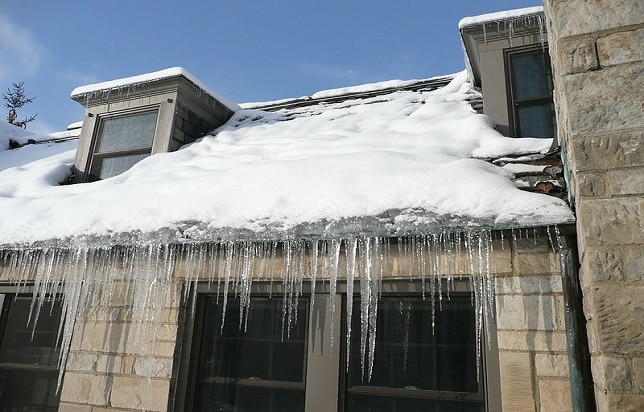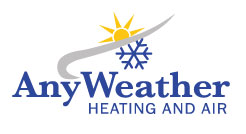
Winter is here in the Northern Kentucky – Greater Cincinnati, OH Tri-State area and with it comes cold temperatures, snow, and Ice. Many of us like seeing icicles…they can be beautiful, kids love to play with them, and they represent iconic imagery of winter. However, they may be a sign that a roof is not properly handling/draining the water that results from snow melting.
All parts of a roofing system work together to prevent water (and ice) from penetrating the roof and causing water damage to your home. Ice and water underlayment products are an important part of the roofing system when it comes to keeping moisture out.
Precipitation hits the roofing shingles first. Once the rain or snow land on the shingles it runs down into the gutters. The gutters drain into downspouts which help to drain water away from your home’s foundation. This ideal water flow can be disrupted which can lead to standing water on your roof, which can lead to water getting under the shingles of your home.
The National Roofing Contractors Association lists three primary situations that can lead to roof leaks: Ice Dams, High Winds, and Clogged gutters. The declining temperatures and abundance of snowfall in the Winter months have the potential to leave homeowners with extensive roof damage…especially when ice dams form.
What Is An Ice Dam?

Ice dams, also known as icicle barriers, form along the edge of a roof when snow melts and eventually refreezes. This block of ice, often highlighted by icicles, forms a barrier that is called an Ice Dam. The water that gets trapped behind an ice dam can leak inside a home. It is important to know what risk factors can lead to ice damming as well as how to lower your risk for water damage caused by the ice dams.
Where is an Ice Dam Likely To Occur?
Ice Dams can occur on most types of roofs. A home or building with a low roof slope and large overhang provides an optimal configuration for ice dam formation to occur. In addition, the combination of snow accumulation with the outdoor temperature of roughly 10 degrees below freezing creates an ideal environment for ice dam formation to occur. Finally, when heat is radiating through the roof due to poor insulation, the odds of an ice dam forming are greatly increased.
Ice Dam Formation and Prevention
Some roofs are better at preventing ice dams than others. If you begin to notice icicles forming on the edge of your roof, you may want to consider its risk-factor. Inadequate insulation and higher attic temperatures can leave your home at a higher risk for water damage. Keep in mind, there are steps you can take to lower your roof’s risk factor. A low-risk roof will help to prevent ice damming and protect your home.
Adequate Attic Ventilation and Insulation
Two important prevention strategies for preventing ice damming are properly ventilating and Insulating your attic. Improper ventilation and insulation can cause the temperature in your attic to rise. Improper insulation allows your attic to heat up which causes snowmelt and ultimately ice damming.
Improper ventilation can also cause heat loss in the attic which also causes snowmelt and ice damming. It can also lead to condensation inside, on the roof deck. This condensation can cause roof decking rot and mold. The roofing contractor experts at AnyWeather Roofing can work with you to ensure that your attic is properly insulated and ventilated.
Gutter and Downspout Maintenance
Problems with a homes gutters and downspouts are usually not the cause of ice dam formation. However, a clogged gutter that becomes iced over can be the cause or a contributing factor. As a result, it is best to make sure gutters and downspouts are cleaned and working properly before winter weather hits.
Ice and Water Barrier Underlayment
In addition to adequate ventilation and insulation, Ice and Water barrier underlayment is an important factor in lowering the chance for water damage. This impermeable barrier is self-sealing, waterproof, and self-adhesive. It adheres directly to the roof decking and seals tightly around the roofing nails helping to keep moisture out. This protection can be added to the following areas on your roof.

Eaves: Wind can catch the shingles on these exposed areas which can let water in. Water backups from clogged gutters can also lead to roof leaks.
Valleys: as rain runs down the peaks and slopes of your roof, it can collect in the valleys. This runoff makes valleys one of the most vulnerable parts of your roof.
Roof Penetrations: Openings for skylights, vents, and chimneys penetrate your roof and leave areas that can be vulnerable to water leaks. Ice and Water barriers around these penetrations help to seal any gaps and protect your roof.
Entire Roof Surface: Although it is the most expensive option, Ice and Water barriers can be placed on the entire roofing surface. This means that even if shingles are damaged or destroyed during a storm, your roof deck is still protected.
Do You Need Help Fixing an Ice Dam?
Now you know ways to prevent ice dams, however you may be asking, how do we fix them if they do happen? Your first instinct may be to attack the problem at its source with force. Put the hammer away! Hacking at the ice with tools often causes more damage. Instead, contact us at AnyWeather Roofing! We service all of Northern Kentucky, Cincinnati Metro, and Dayton, OH.
We can evaluate your roof damage and needs going forward. Some of our suggestions may include…
- shingles
- additional ventilation/insulation
- ice/water barrier products
Water leakage causes the following problems:
- warped floors
- stained ceilings
- peeled paint
- soggy insulation and others
Rest assured, when people choose AnyWeather Roofing they are working with the best Cincinnati area roofing company!





